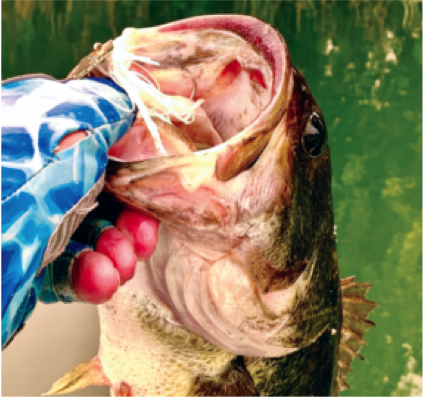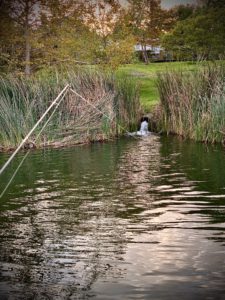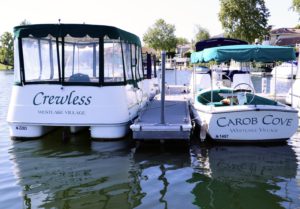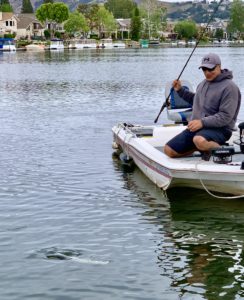
BY JON DICKENS
I’ve always liked bass fishing. But not in the summer. Too hot. Too hard to find fish. And too hard to find fish that will bite. Ever felt that way too?
Summertime is when I used to switch gears and go back to my first love, saltwater fishing, until last summer when the pandemic had me fishing freshwater more so I didn’t have to worry about social distancing on party boats.
During that time I did a little online and on-the-water research and figured a few things out. Certainly not enough to make me an authority, but enough to give me the confidence that I could typically catch at least a few fish each trip.
Unlike other times of the year, there are two stable patterns that hold true throughout the summer without much change. The fish are either going to be shallow or deep. Now that’s a pretty broad statement, but following are some tips to consider when determining where and when to fish each of these patterns.
Pattern #1: Fish shallow and look for current and cover
In most lakes and reservoirs, the water heats up in summer to the point that it causes fish to look for cooler and more oxygenated water. Many anglers think that means to go deep because the shallows will be hotter. Reasonable thinking, but not always accurate. If you find current and cover, the shallows can hold plenty of bass. There will always be groups of bass that stay shallow, and groups that stay deep — pick your poison.

Current is something that you should always pay attention to regardless of depth. If you fish saltwater much, you’ve probably heard skippers say that the fish weren’t biting because there was no current or because it was running in the wrong direction. While there are other factors like water temperature, bait, wind and so on that cause the fish to bite or not, most captains would probably agree that having current is the most important condition needed.
Lakes are no different. The current, which is often created by wind, oxygenates the water and can lower the water temperature at times, while bringing bait through a bass’ front door. It keeps the bass engaged and active. Find the current, cover and bait, and you’ll find the bass. And remember, you generally want to fish with the current, not against it or across it. Your bait should mimic the direction that the natural forage is flowing.
I read an article in Bassmaster Magazine by Ken Duke a number of years ago that gave a great example of how current affects bass. Here’s an excerpt:
“For 20 years, I had a 5-acre pond behind my house. One summer I decided to conduct an experiment with current. I put an electric pump in the pond and ran a hose out toward the middle. When I turned the pump on, it created an artificial current. I left it on overnight so the fish could get used to it, and then I went out the next morning to do a little fishing. Casting a crankbait out into the current created by the pump, I caught bass after bass. Once I turned the pump off, eliminating the current, the bite fell off dramatically.”
Shallow water cover
While the above experiment confirms the importance of current, you also need cover. There are many kinds of shallow water cover that hold summertime bass. The most common is probably vegetation, which also produces oxygen. If your lake has hydrilla, milfoil, lily pads, cattail or another form of vegetation, you’re in business. If not, look for brush, overhanging trees, flooded timber, lay-downs, and my favorite: boat docks.
Typically, I’d start the day looking for bass in the shallows before venturing to the second

pattern — deep water. Early in the morning, the shallow bass are more likely to be spread out, looking for breakfast. Look for “pinch points” where the water narrows and has current. This could be a bridge that narrows and funnels water through, a creek channel rounding a point, water flowing into the lake, etc. The pinch point can direct bait through or next to the cover just like a drive-thru restaurant. The bass will be laying in wait for delivery of their morning Egg McMuffin.
In the case of dock cover, assess all the targets there before you start casting. You want
to cast to the most outward piling or corner first so you don’t spook any fish farther under, and then work your way back under the dock. And of course, the shady areas should be the most productive. If there’s one shady spot where the water seems darker, it’s probably deeper and more likely to hold a bigger fish.
Once the sun creeps higher overhead, you’ll see shadows in the shallows become more defined and the bass will head for these shade pockets. Remember, they don’t have eyelids or sunglasses so the shade is their sanctuary. This shade makes for very predictable bass hideouts and I’ve found that it makes it much easier to locate individual fish. Look for hard-edged shadows created by docks and boats, overhanging trees and bushes, trees on flooded flats, cuts or indentations in the banks, bridges, weed lines and so on.
What to throw in the shallows
Ask 10 anglers what they throw at summer bass in the shallows and you’re likely to get 10 different answers. However, there are some pretty common choices that you can’t go wrong with. One of the most universally used baits is a 5-inch or 6-inch weightless Senko or other stickbait. When wacky-rigged, the tantalizing flutter as they slowly descend will get a bass’ attention like a cheerleader waving her pom-poms.
If you’re fishing mats, lily pads or reeds with visible lanes or openings that you can cast to, a frog can’t be beat. Whopper Ploppers and other surface lures are also effective. If you want to get below the surface, lightweight swimjigs with paddle tail trailers, spinnerbaits, and of course, chatterbaits will call the bass in. In dense cover, aim a weedless punch rig with a high profile trailer on heavy braided line at the darkest shadows you can find. Mama might just be waiting there.

Pattern #2: Fishing deeper water
Bass generally move deeper looking for cooler more oxygenated water than is found in the hot summer shallows. As mentioned above, that’s not to say that there still aren’t
fish up shallow too. It’s kind of like, where do you want to vacation this summer? At the beach, or up in the mountains? You’ll find crowds in both locales.
Before venturing out into the deep, spend some time looking at contour maps for the best structure spots. Look for intersections. Locations where a roadbed crosses a field of timber or a creek channel meets a secondary point. Look for something irregular compared to the rest of the structure on the lake. Bass hotels.
Just like in the shallows, you’re still looking for current and bait, but here instead of overhead cover, you’re looking for structure — rock piles, humps, creek channels and the like. If you start off by graphing some areas and find that the bait seems to be hanging at 15 to 20 feet, look at your pre-determined targets for structure intersections in that depth range, even if there’s no visible bait there yet. Keep in mind that water below the thermocline, that layer of water that separates warmer from cooler water, won’t hold bass there for long, if at all. It doesn’t have enough oxygen. So keep your search in the water column to above the thermocline and look for a “sweet spot” on that structure intersection. Could be a tree stump, a rock pile, etc. Just might be a honey hole.
School’s in session
One advantage of fishing deep for summer bass is that you’re more likely to find a school of fish instead of one here and one there, like in the shallows. These schools are often rock-oriented. They’ll sit below a ledge or rock pile with the current bringing bait above them, and then dart up to pick them off. Sometimes you’ll meter bass in conditions like this but they don’t want to bite. It could be a time of day thing or you’re not throwing the snack they’re looking for. Sometimes it just takes getting one fish to bite to activate the whole school.
Though it was in a shallow water situation, I had this occur just last week at a little manmade lake I sometimes fish from shore. There’s a natural pinch point where one bay narrows down through a cut and empties into another small bay. At one end of the narrow cut is a bubbler that oxygenates the water. Between the current created by the narrowing banks of the cut and the bubbler, this is usually a great spot to target, especially in the summer. I threw Senkos, small swimbaits, an underspin and several other baits without success, but stuck it out because I thought there were fish there. A cast towards a far bank just past the cut and about 15 feet from the bubbler finally got a bite on the Senko. Next cast, another fish. Then a cast at the bubbler and another hit. I got six fish from that spot in about 20 minutes. It just took one fish to activate the whole school.
Because bigger bass (five-plus pounders) in deep water aren’t likely to school up, you’ll have to cover more water to find them. Bigger fish generally want bigger baits, so keep that in mind as well if you’re after the big girls. Warm-water fish are sometimes aggressive so throwing brightly colored or shiny crankbaits in clear water are a good search tool. Squarebills in mid-depth ranges and deep cranks like a 6XD or 10XD are commonly relied upon. If they’re not responding to those, try a shakey head worm or a jig, or a swimbait like a 6-inch Keitech on a leadhead. Sometimes burning it through the zone for a reaction bite is a good technique.
When using crankbaits, you might want to go with a deeper diving bait than what the package says the bait will dive to. If you want to target the 15-foot depth, go with a bait that the manufacturer says dives to 18-feet, because they’re using ideal conditions — light line and perfect water conditions — to reach those depths. That rarely happens in real life.
Another detail concerns rigging and tuning your baits properly. When throwing a crankbait, watch the way it tracks through the water. If it’s leaning to one side or not swimming straight, use your pliers to bend the line tie of the bait in the opposite direction. With swimbaits and worms, make sure you thread them onto the hook or jig head so that they are perfectly straight with no bunching up or curves in the front end of the plastic. A drop of super glue where the bait meets the jig head or line tie of the hook should keep the bait from sliding down when you get bit too.
Summer bassin’ doesn’t have to drive you crazy But let’s face it. There are going to be days this summer when the temperature hits triple digits and you say, “What the heck am I doing out here?” And in those situations, you’d probably be better off watching Major League Fishing on TV and sipping a cold one. But the rest of the time, consider some of the tips above to determine where and how to fish for those crazy summertime bass. The rewards just might be worth the challenge.



